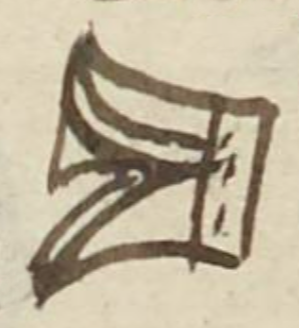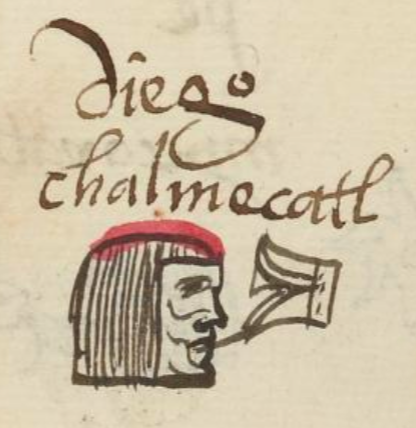Chalmecatl (MH506r)
This black-line drawing of the simplex glyph for the personal name or ethnic origin if a man named Diego Chalmecatl. He may be from a town called Chalma (today). The glyph shows a shape that vaguely recalls the "beak" of Ehecatl, facing toward the viewer's left. This element might be intended to represent the suffix of the name -ecatl, given that Ehecatl names are often glossed as Ecatl. The Chalm- root, however, does not seem to appear visually, unless Ehecatl has a semantic connection to Chalma, a famous pilgrimage site since the autonomous era.
Stephanie Wood
Gabrielle Vail and Christine Hernández (Re-Creating Primordial Time, 2013, ) describe Ehecatl as the wind aspect of Quetzalcoatl, and they note that Ehecatl "wears a buccal (duck) mask through which to blow wind." That the "beak" may have been perceived as a blowing device is supported by the glyph for Pitztli (below).
Stephanie Wood
diego
chalmecatl
Diego Chalmecatl
Stephanie Wood
1560
Jeff Haskett-Wood
etnicidades, deidades, divinities, deities

Chalmecacihuatl, a deity; "Woman of the Chalmeca (inhabitants of Chalman, today called Chalma)", https://nahuatl.wired-humanities.org/content/chalmecacihuatl
Una Persona de Chalma
Matrícula de Huexotzinco, folio 506r, World Digital Library, https://www.loc.gov/resource/gdcwdl.wdl_15282/?sp=91&st=image
This manuscript is hosted by the Library of Congress and the World Digital Library; used here with the Creative Commons, “Attribution-NonCommercial-ShareAlike 3.0 License” (CC-BY-NC-SAq 3.0).






